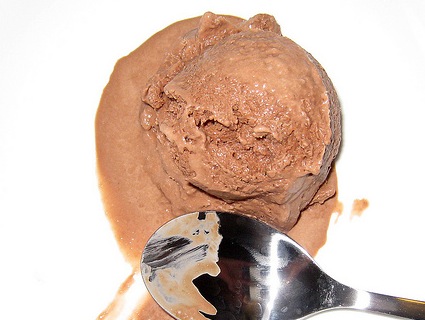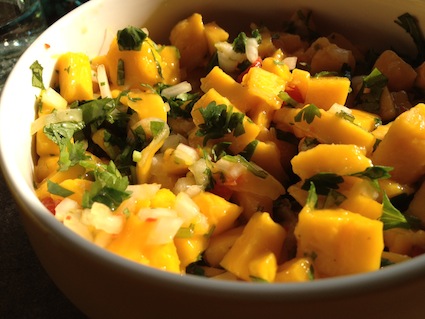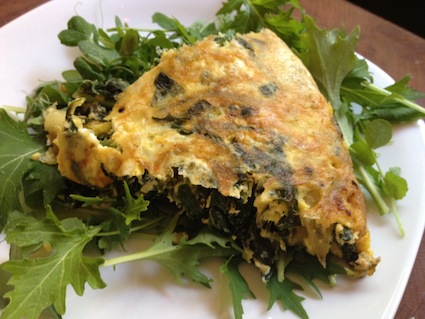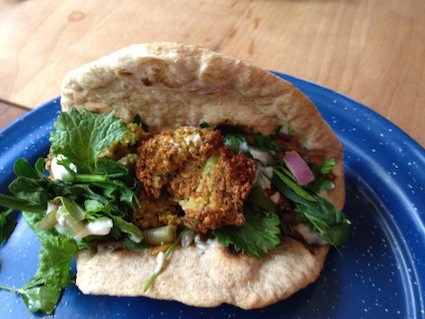
<a href="http://www.flickr.com/photos/legumeandthelady/3366449201/">Penelope the Library Cat</a>/Flickr
Somewhere, there exists a photo of three-year-old me with an ice cream cone crammed by my tiny fist into my face, which is marked with dark splotches of Rocky Road. My expression is focused, beatific, like that of a religious fanatic at prayer. To this day, I remember howls of adult laughter echoing around me. I didn’t give a damn—what mattered was getting that creamy, crunchy, sweet stuff into my mouth.
I try to play it cooler these days, but the joy I take in the famed cold confection has changed little. I don’t eat ice cream everyday, as my three-year-old self vowed I would once I threw off the yolk of adult meddling. But I do love a little of it it now and then, especially when I’m feeling dented.
But not just any ice cream. When I really need ice cream therapy, I like to make it myself. With just a simple piece of equipment—an inexpensive ice cream maker with a freezable mixing bowl, plus an instant-read thermometer—you, too, can make your own ice cream without much fuss. I have for years used a an older version of this $60 Cuisinart model, which can often be found for super-cheap at thrift shops (since not everyone is obsessed enough to actually make ice cream after obtaining a maker).
Now, good ice cream is perfectly smooth, and the scourge of the home ice cream enthusiast is little frozen crystals. But if you follow a couple of tips—properly heating the custard and adding a little bit of liquor at the end to raise the custard’s freezing point—then you should be fine.
What follows is my recipe for my favored ultimate blues-chasing ice cream flavor: straight-ahead chocolate. My main influence over the years has been Cook’s Illustrated articles on ice cream I read in the 1990s.
Chocolate Ice Cream
2 cups whole milk, preferably from grass-fed cows
2 bars (7 oz total) of good-quality, Fair Trade dark chocolate, at least 60 percent cocoa
1/3 cup unsweetened cocoa powder
1 cup heavy cream, preferably from grass-fed cows, well-chilled
5 free-range eggs, yolks and whites separated, whites saved for another use
1/2 cup raw, organic cane sugar
1 pinch of your best coarse sea salt
1 tablespoon good-quality vodka
Chop the chocolate into fine pieces, and place them in a small metal bowl. Set up a double boiler by placing a the chocolate-containing bowl over a saucepan with an inch of lightly simmering water, and let it melt, stirring occasionally. Remove it from the heat when it’s melted. Meanwhile, combine the 2 cups of milk with the cocoa in a medium sauce pan and turn heat to medium. Whisk constantly to combine the cocoa and milk, while bringing the mixture to about 140 degrees. Turn heat off.
Now put the egg yolks in yet another mid-size metal bowl, add the sugar, and whisk vigorously until the sugar and eggs are well combined. Next you’re going to “temper” the yolks—bring their temperature up slowly in preparation for making the custard. If they heat too fast, you’ll get scrambled eggs. To do this, take a ladle and grab a bit of the hot milk from the saucepan and add it to the to the yolks, stirring as you pour. Add a little more, continuing to stir; and a little more; and a little more still, stirring the whole while. Now dump the bowl with the now-warm egg-milk mixture into the saucepan with the rest of the hot milk. Using a spatula to scrape, add the melted chocolate, plus the pinch of salt, and stir to combine. Turn heat to medium-low, and stirring constantly, cook the mixture until it thickens, bringing it to about 175 degrees. Pour it over a fine strainer into a container that can hold it with room to spare.
Immediately pour the cold cream into the custard, and stir to combine. This will immediately stop it from cooking, as well as help it cool faster. Add the vodka and stir again. Cover and let it chill for several hours in the fridge until it is 40 degrees or lower. (You can speed the cooling process by putting the custard in yet another metal bowl and placing it over a larger bowl with plenty of ice and salt, thus creating an ice bath.)
Freeze according to your ice cream maker’s instructions, and enjoy.
















